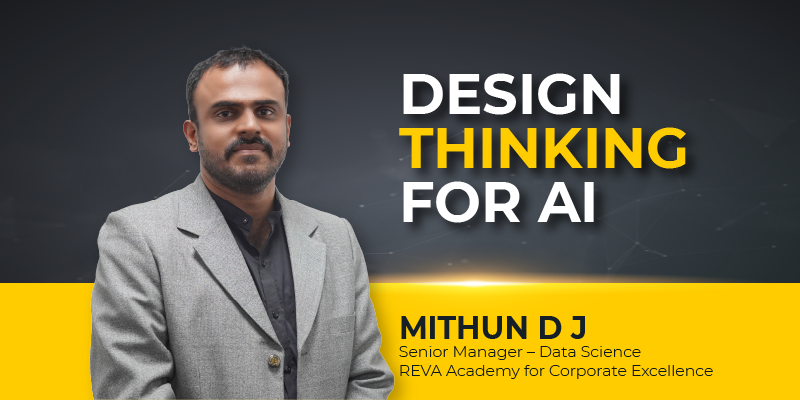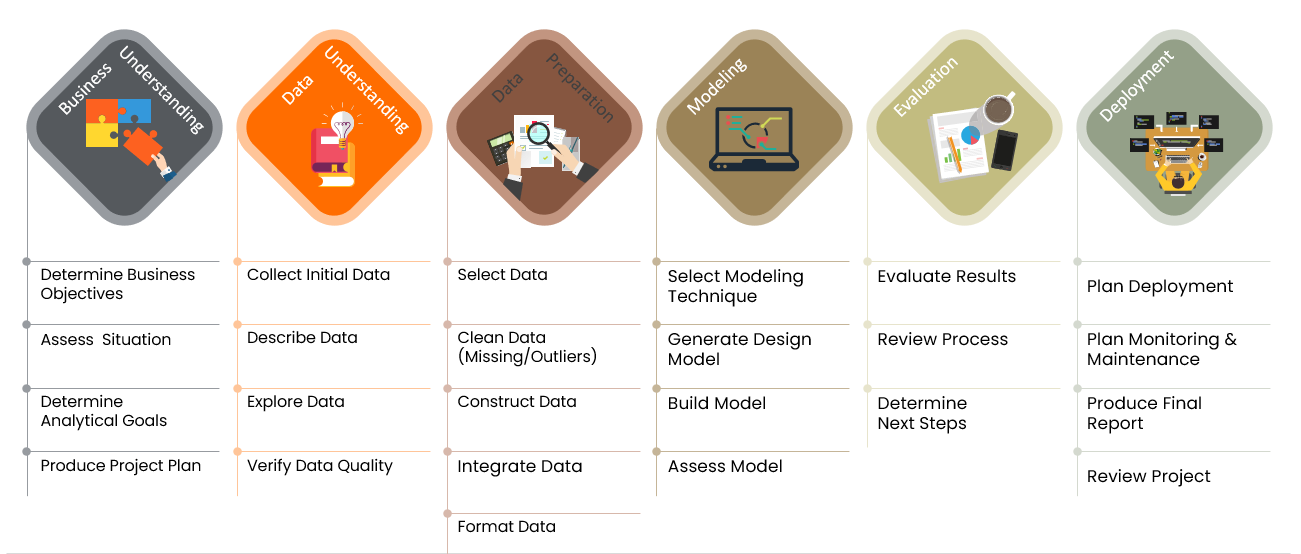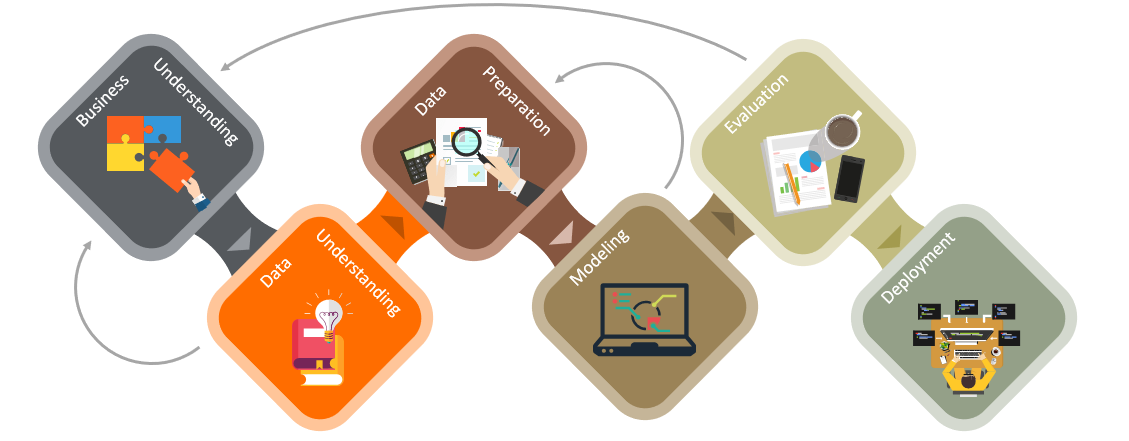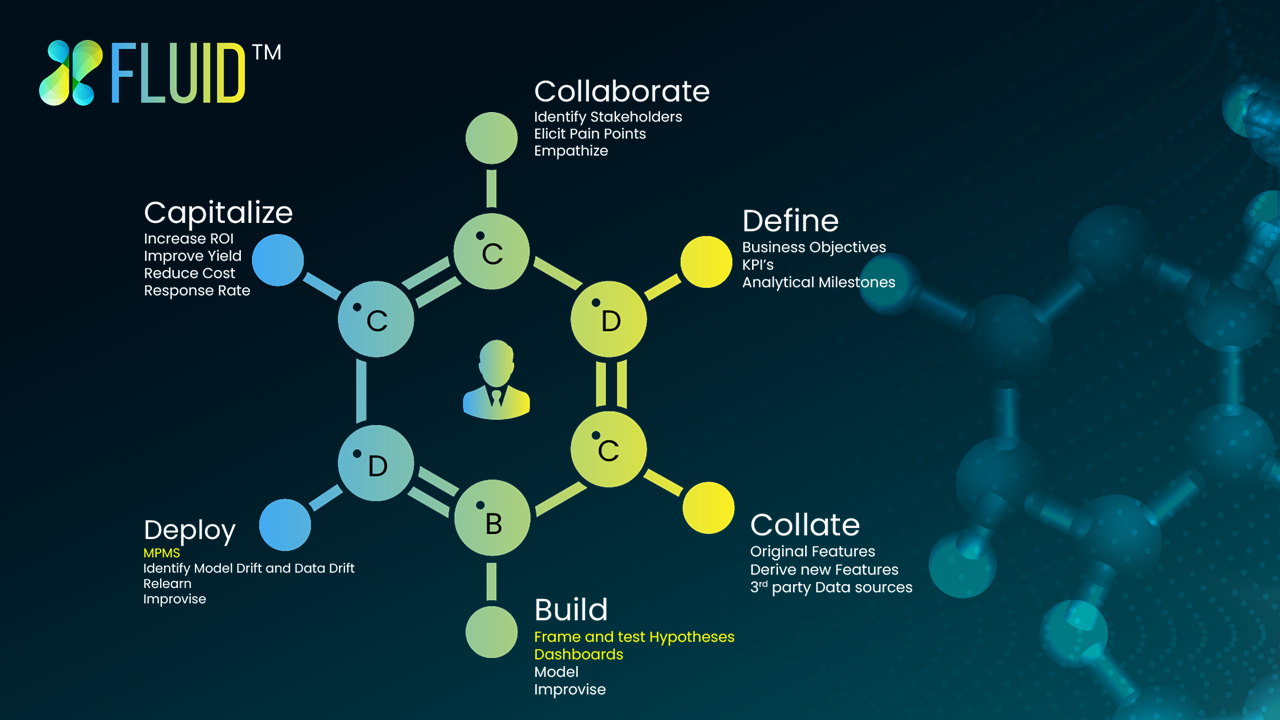Design Thinking for Artificial Intelligence

Design thinking is a very powerful framework that blends non-linear cognitive and strategic thinking to enable decision-makers to drive high value and optimize efficiency for the organization. Design thinking relies more on people-centric as opposed to a process-centric approach. From the viewpoint of an organization, design thinking is a great model for long-term success. Hence, organizations can incorporate design thinking into the current AI model as several analysts believe that design thinking and AI can bring in futuristic innovations.
In this blog, you will come across existing frameworks on analytics, drawbacks of existing frameworks, new framework launched by RACE, and the merits of RACE’s framework.
Existing Frameworks
Some of the existing frameworks in the current market are CRISP-DM, SEMMA, KDD, Team Data Science Process Lifecycle (TDSP), Kanban, Kaizen, and DMAIC.
CRISP-DM (Cross-Industry Standard Process for Data Mining) is one of the popular frameworks used to analyze data, which is in the market for an extended time. IBM has popularized Crisp-DM in the last couple of decades. This methodology offers a structured approach to planning a project in data mining.
SEMMA stands for Sample, Explore, Modify, Model, and Assess, which is a data mining process with five steps. SAS mainly relies on SEMMA as it is developed by SAS Institute.
KDD (Knowledge Discovery in Databases) is a process of discovering knowledge from data. This data mining technique includes data preparation, data selection, data cleansing, and incorporation of prior knowledge collected from data sets, and interpretation of solutions from the applicable knowledge.
TDSP (Team Data Science Process) is an agile methodology popularized by Microsoft, used to build and deploy intelligent applications and predict analytics solutions.
Kanban– A popular framework and simple approach for managing complex problems. It is a flexible approach to manage work effectively by releasing the team from overburdening, yet providing customer value in a swift manner. This method emphasizes visualization or visual presentation.
Kaizen– Promotes progressive change management in business and is often considered as the building block of all lean production methods. Kaizen aims to involve employees from various domains and levels within the organization to enhance a process or address the problem.

DMAIC– DMAIC stands for Define, Measure, Analyze, Improve, and Control, a five-phase data-driven improvement cycle utilized to improve, optimize, and stabilize business designs and processes. DMAIC is the main tool used to drive Lean Six Sigma projects.
Key Challenges of Existing Frameworks
This article focuses mainly on the challenges of existing frameworks such as CRISP-DM and TDSP.
CRISP-DM process is made up of 6 phases such as business understanding, data understanding, data preparation, modeling, evaluation, and deployment.

The CRISP-DM methodology served the community of data scientists for around 20-25 years, it was the first attempt to standardize the data mining process.
However, there are a lot of challenges in this methodology. One of the major disadvantages of this methodology is that in the second phase, i.e. in the data understanding stage, the clients and end-user do not have a collaboration with the data science team. In the data understanding stage, the data science team works in silos indicating that it is a process-driven approach. Another disadvantage is that from the 2nd phase to the 5th phase of the CRISP-DM process, data scientists are leading the process, and clients and end-users are not involved in the process.
TDSP: The TDSP lifecycle consists of 4 stages such as business understanding, data acquisition, modeling, and deployment. There are challenges in this model as well. The methodology is more process-centric and from the second stage of the process, data scientists drive the process. In this process, a linear approach is used that does not rely on the complexity of real-time data scenarios.
In short, the key challenges of using the existing frameworks are:
- Lack of collaboration between data science team and business team
- Lack of empathy creates a lack of understanding of the pain points of the end-user
- Multiple stakeholders are getting affected by the solutions provided.
- Addresses only SISO i.e. Single Input and Single Output
- Linear approach
Hence, the need of the hour is to develop a non-linear approach that should not be confined to a single stakeholder but to offer solutions to multiple stakeholders.
What is Design Thinking?
Design thinking is an iterative and non-linear process used to understand end-users, challenge rules, redefine problems, and develop innovative solutions. Design thinking is a human-centric approach to innovation, which can be used irrespective of your chosen domain and stage in your career. Design thinking involves five phases such as empathize, define, ideate, prototype, and test that help in tackling the undefined business problems.
Design Thinking + AI: The Potential for Real Collaboration- FLUIDTM

The new approach proposed by RACE is the FLUIDTM approach, which is developed in-house at RACE. This approach initiated by RACE can address a lot of challenges in the existing frameworks effectively. FLUID is a multidisciplinary approach with a combination of the best from design thinking and the existing frameworks.
The FLUID technique is created out of five different elements -Design Thinking, Cognitive Sciences, Kanban, Kaizen, and Visual Analytics. The FLUID technique is made up of 6 phases such as Collaborate, Define, Collate, Build, Deploy, and Capitalize.
Collaborate: In this phase, it addresses the challenge of existing frameworks, i.e. lack of collaboration. The three critical elements addressed in the collaborate stage by FLUIDTM are it identifies the internal and external stakeholders, elicits the pain points of the end-users, and empathizes with the end-users.
Define: In this stage, the problem will be defined in simple language. The problem will be defined from the point of the stakeholder or end-users, by considering the business objectives, by identifying the KPIs, and by understanding the analytical milestones to be solved to address the challenges.
Collate: As part of the data science team, you will be giving a lot of emphasis on algorithms. The data science team usually considers what algorithm is best for driving higher ROI. In this stage of the FLUIDTM technique, RACE is proposing a refreshing change by leveraging the original features/variables/dimensions from the data. Manufacture or derive new features with the help of the marketing team, end-user, and subject-matter experts.
How do you derive new features? There are lots of tools in Python known as feature tools that help to do a simple calculation and manufacture relevant features. How do we know whether the new features created are relevant or not? The easiest and simplest way is to check it during the modeling stage to know whether it is a key driver for the ROI.
In this stage, you should reach out to the third-party data while harnessing the power of original features and new features as in-house data might not be sufficient to drive high ROI. Third-party data will contain more recent and relevant data that can drive higher ROI.
Build: Rather than building a fancy model right after the data preparation stage, the FLUID technique emphasizes framing the hypothesis after the collate phase. Business stakeholders are the best people to frame a series of hypotheses that help to solve the business pain points in the first stage of this phase. Once the hypothesis is framed, it can be tested to address the challenges identified so far.
The second stage is the creation of a dashboard as it is a powerful tool that provides early warning signals on the potential challenges. Once the framing of hypotheses and dashboard creation have been completed, the model building can be taken into consideration only if it is necessary. Model building is not mandatory to address the challenges.
Deploy: The fifth phase is the deployment stage. Once a model is built, it has to be deployed. Model Performing Monitoring System (MPMS) is used to track two important elements or challenges- data drift and model drift. Data drift is the changes that happened in the data because of external or internal factors. Model drift is also necessary as the old model might not meet the current demands and new models have to be created to address the current challenges. To address the current challenges, the model has to relearn the characteristics from the data.
Capitalize: The final phase of the FLUID technique is Capitalize. In this phase, the performance of the model will be evaluated whether the new model is capable of increasing the ROI, improving the yield, reducing the cost, and increasing the response rate.
Wrapping Up
FLUIDTM technique offers a human-centric approach than process-oriented approach of existing frameworks. FLUIDTM empathizes with the stakeholders much better than the existing frameworks. This technique addresses the prototype testing phase better than the other frameworks.
FLUIDTM framework gives more emphasis on co-creation i.e. this framework is required to work with both data science and business teams. Unlike other frameworks, this new technique also gives a lot of emphasis on model maintenance. Another biggest advantage of FLUIDTM is that it addresses not only SISO but also SIMO (Single Input Multiple Output), MIMO (Multiple Input Multiple Output), and MISO (Multiple Input Single Output).
Watch the video on Design Thinking for Artificial Intelligence to know in detail about the FLUIDTM technique and the use case on campaign analytics.



